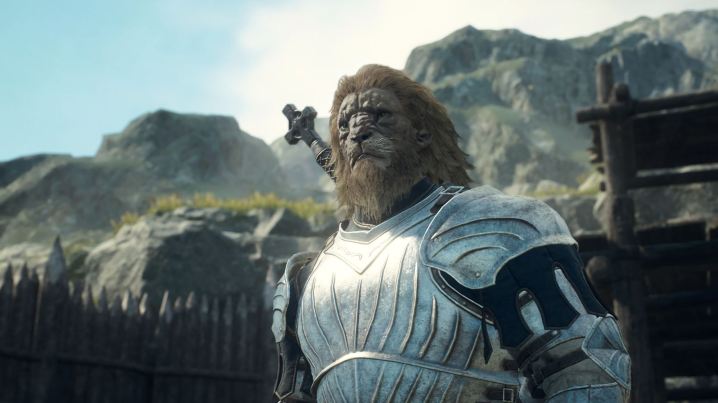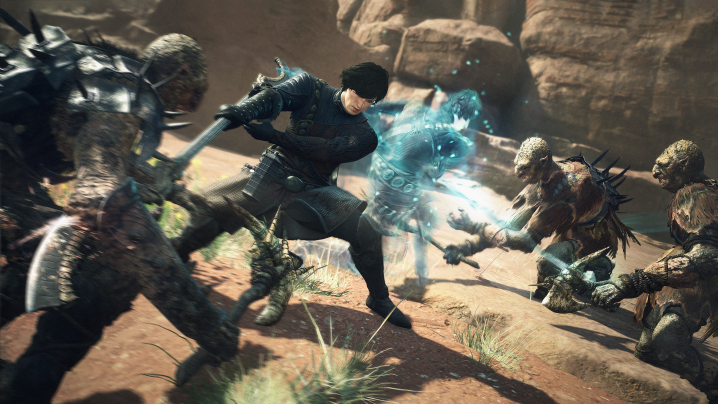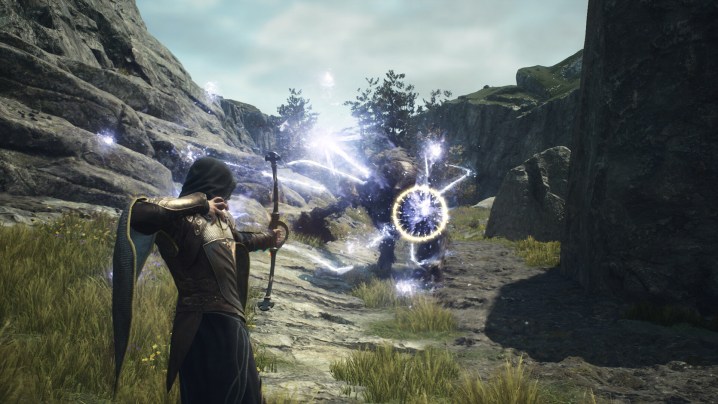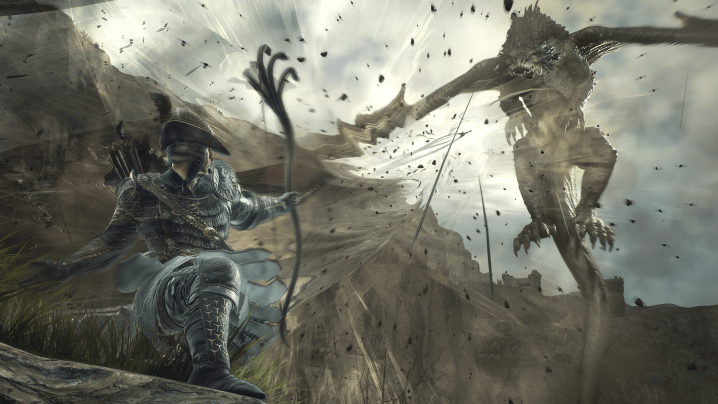“Dragon's Dogma 2 is an exhilarating, if occasionally frustrating, RPG full of dynamic player-driven moments.”
- Full of exciting emergent moments
- Tense open-world exploration
- Vocation and Pawn systems
- Encourages player creativity
- Slow start
- Frequent frame rate issues
- Poor save system
Last week, a Dungeons & Dragons adventure I took part in with some friends went terribly wrong. Our DM created a small encounter with some mummies in a graveyard as a fun side excursion during a larger quest, but a series of bad rolls turned it into a bloodbath. Players were nearly killed, my health was permanently debuffed, and an encounter that should have been over in a turn or two took the whole session to beat, escape, and recover from. Emergent moments like that are what draw people to RPGs, and it’s a style of video game design that’s only getting more popular with the likes of The Legend of Zelda: Tears of the Kingdom, Baldur’s Gate 3, and Helldivers 2.
Dragon’s Dogma 2 from Capcom is the latest in this wave of “emergent games,” and it’s one tailored to the most hardcore of players, for better and for worse. I’ll never forget the moment when I was riding in a wooden gondola above the desert of Battahl, only for a boss-level creature to appear out of nowhere and fly into the gondola, destroying it and causing me to fall to my death. I also won’t soon forget the game’s poor save system, which sent me back to replay over 30 minutes of gameplay after it did that.

This is one of Capcom’s most ambitious games ever. Dragon’s Dogma 2 sports a large open world, 10 varied vocations for players to master, deep character creators upholding a pawn-sharing system, and towns full of NPCs that operate on schedules and can permanently die. It’s also one of the worst-looking and worst-running games on the RE Engine, its game design feels unpalatably old school in some ways, and it’s not quite as instantly fun as the other emergent games I mentioned. Those searching for a diamond in the rough will find lots eventually, but it’ll take a proactive effort on the player’s part.
Emerging with Power
For a game where a lot of dynamic moments can feel like they are out of the player’s hands, it’s ironic that the narrative of Dragon’s Dogma 2 is about control. Players control an Arisen, a moniker given to people who have their hearts stolen by a dragon and can control universe-hopping Pawns. Being an Arisen fulfills a prophecy and is supposed to make the player the ruler of the kingdom of Vermund by default, but its queen doesn’t want to lose power, so she wipes the Arisen’s memory and sends them to a prison camp.
Eventually, the Arisen escapes captivity, regains their memories, and then works to stop the plotting of the queen and the leader of the kingdom of Battahl, who want to retain power in a world where they feel they are losing control. It’s a narrative not afraid to question if people truly have free will while under the control of someone else, something exemplified by Dragon’s Dogma 2’s pawn system. Ultimately, players assert their free will at various times during the story and gameplay by how they respond to important choices presented to them.

That’s interesting thematically, but its story never fully coalesced for me, namely due to the game’s presentation. Through the Resident Evil remakes, Devil May Cry V, Street Fighter 6, and Exoporimal, the RE Engine cemented itself as the driving force behind some of the most beautiful-looking and best-running video games on the market today. You couldn’t tell that by looking at Dragon’s Dogma 2, which makes RE Engine buckle under the weight of this game’s ambition. Frame drops are frequent in cinematic cutscenes, and facial animation and cinematic framing is terrible when conversations take place in the world. No matter how compellingly a character is written, it’s tough to care if the game doesn’t present its moments well.
By the time the credits rolled on the true ending, I can’t say I was particularly attached to any of Capcom’s created characters. I felt a bit more attached to my pawns, especially the one I made myself and one made by one of our freelancers. Still, the list of quips that pawns had to pull from did get repetitive within 10 or so hours, and they sometimes didn’t make sense, like when a pawn talks about having gone on adventures with an Arisen who slept around, only for another to say that was “well worth hearing.”
Those moments are funny, but overall, the pawns lack personality compared to the companions in Dragon’s Dogma 2’s contemporary RPG. It’s neat that you can make a friend or some abomination in the immensely detailed character creators and recruit the pawns your friends make, but I’d have much rather feel like I’d made a new friend, as I did with Karlach, Shadowheart, and Gale in Baldur’s Gate 3. Ultimately, Dragon’s Dogma 2 is more about the stories players make for themselves while on a journey, rather than the one Capcom handcrafted for them.
An unexpected journey
Dragon’s Dogma 2 is an expansive and brutal open-world RPG, and the Arisen’s journey makes that clear while traveling all around the regions of Vermund and Battahl. The former is a mountainous and forested nation full of hidden caves and other nooks and crannies to discover, while the latter is a harsh desert full of formidable enemies and significantly fewer towns and places for respite. There are no mounts, and fast travel is based around a limited resource or oxcarts that move on restricted paths and can get ambushed, so every excursion in the open world is a nail-biting event.

As I would in a Dungeons & Dragons campaign, I’d spend a lot of time properly preparing myself and my pawns for the journey, even if I knew that it was almost inevitable that we’d come up against some tough threat during our travels. I had 10 vocations to choose from in Dragon’s Dogma 2’s class system, and each vocation offers a wildly different playstyle. My favorite was Mystic Spearhand, which mixed magic and close combat and allowed me to stun enemies before swooping in with a powerful strike. I could also use other skills to regain stamina or temporarily become invincible.
Combat isn’t as fluid or smooth as in Devil May Cry V, director Hideki Itsuno’s previous outing. Like most aspects of the game, combat trades perfection for breadth. All the vocations differ from each other, and all the different skills available to each vocation mean that another Mystic Spearhand could have a very different playstyle from me. Exploring and fighting are the only two languages all of Dragon’s Dogma 2’s emergent gameplay systems can communicate in, so don’t be afraid to experiment and find the vocations you like best early on, as not doing so will make the experience significantly less enjoyable.
Keep in mind that your pawns can have different vocations than you as well. I’d recommend having a mage that can heal you always on hand as a pawn, as health is a very finite resource due to the loss gauge that makes the Arisen’s total health reduce by a bit each time a strong attack hits them. While smaller goblins or thieves are the most common enemies in Vermund and Battahl, larger monsters will also appear, sporting several health bars and aggressively attacking the Arisen just as you’re getting close to a location for a quest.

All of those systems work in tandem to become an engine to create dynamic moments during every adventure. Perilous is the word I’d use to describe many of my early-game journeys in Dragon’s Dogma 2, which has advantages and drawbacks.
Unabashedly old school
Dragon’s Dogma 2’s game design enables some unexpected moments to take place. I remember pushing a troll over to get across a gap after it had destroyed a bridge during a fight. I recall the intensity of fighting for my life around a campsite with a sliver of health left so I could recover the total health my loss gauge had taken away. I’ll never forget the power trip I felt during the first excursion when I switched from the discount-soulslike Fighter to the Mystic Spearhand.
Those situations are what make Dragon’s Dogma 2, producing moments that will likely go viral on platforms like TikTok and YouTube. But the game’s hard edges sometimes make the experience painful. I appreciate that the game has an old-school approach to difficulty without going full Soulslike. What I don’t enjoy as much is a not very fun early game, terrible save system, and poor mission direction. It took about five hours for Dragon’s Dogma 2’s systems to start singing for me, and I’ll admit I wasn’t feeling into the experience before that.
If you’re someone who bounces off games quickly, Helldivers 2 is a much better choice if you need a quick fix for emergent gameplay. While the players who stick around will eventually get over those initial woes, all the way to the endgame, the save system and mission design were annoying. Dragon’s Dogma 2 does not allow save scumming, as there are only ever two save slots.

One is your last auto or manual save; the other is your last long rest at an inn or purchased home. I get that Capcom likely wanted to prevent save scumming, but at times, this forced me into frustrating loops where I respawned in the middle of an enemy encounter and immediately took damage. I couldn’t tell if this was an intentional design decision or a glitch, but my loss gauge would also carry over upon death, meaning I’d sometimes have less health when I respawned.
I could have the last inn rest save as a mistake, but whenever I did that, I could lose upward of an hour of progress. As a result, I needed to walk away from the game to vent my frustration. The game is also vague in telling players where certain mission objectives are. Sometimes this is charming, as it requires the player to deduce who to talk where to best resolve the situation or remember somewhere they’d passed on their journey. Other times, the game gives players a vague area to walk around and look for something in, and you’ll miss something like a note that Capcom could have denoted the importance of much more clearly.
Diamonds in the rough
Video games are only getting more and more ambitious. When that pays off, it pays off big. Few games can match the emphasis that titles like Baldur’s Gate 3 or The Legend of Zelda: Tears of the Kingdom place on player choice while still offering a massive amount of engaging content. Dragon’s Dogma 2 gets close to rivaling those titles, but is dragged down by lots of smaller issues that occasionally make it more jank than genuinely enjoyable.

Combat is slick once you’ve found the vocation that works for you, but it lacks the fluidity of some of its action-game peers. It is made worse when the game starts lagging due to an overload of visual effects on the screen. Lots of emergent systems are present — every NPC can die and be revived — but there are whole chunks of the game that are best left avoided unless you’re OK with dealing with some crushingly challenging encounters and frustratingly old-school design choices. When all the different dynamic aspects of Dragon’s Dogma 2 harmonize, though, it’s beautiful.
I’ll admit that crunching to beat this game ahead of an embargo wasn’t the best way to play Dragon’s Dogma 2. You’ll get the most out of it if you take the time to stop and smell the roses, do all the sidequests you can, mess around with all its different emergent systems, and put in the time required to master several vocations. This way, you won’t get as pissed off when a bad save spot screws you over or when you spend longer than seems necessary looking for a mission objective.
For the right kind of players, there are dozens, if not 100, hours of enjoyment to be had in Dragon’s Dogma 2. I’d had my fill of Dragon’s Dogma 2 by the end of my adventure, but I’ll have no problem pitching the game to hardcore RPG fans by recounting the time I pushed an ogre off a massive bridge to its death after it attacked the inn I was staying at.
Digital Trends tested Dragon’s Dogma 2 on an Xbox Series X.





